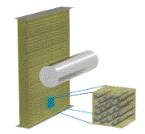Mechanical and Materials Engineering, Department of

Department of Engineering Mechanics: Dissertations, Theses, and Student Research
Date of this Version
11-2012
Document Type
Thesis
Abstract
Quinones are widely found in nature, used in chemistry and medicine, and are just beginning to gain importance in materials engineering. In order to harvest their potential as an ordered or highly crystalline solid, their crystal formation processes need to be well investigated and controlled.
We chose 1,4-anthraquinone, a commercially available type of quinone, as a model compound to study its crystal growth behavior. These crystals were deposited through evaporation of a solution containing the anthraquinone and were subsequently studied through microscopy and various other methods. The effects of solvent variation, temperature, and impurities on crystal growth were all explored.
Control of the anthraquinone crystal growth was partially demonstrated. Poor solvent will discourage crystal growth, high temperatures promote a transformation of needle-like growth to plate-like growth, and butylated hydroxytoluene that are included in solvents will form coral shaped superstructures on the quinone.
These observations show the complexity and promise that quinones, 1,4-anthraquinone in particular, have enjoyed.
Adviser: Li Tan


Comments
A thesis Presented to the Faculty of The Graduate College at the University of Nebraska In Partial Fulfillment of Requirements For the Degree of Master of Science, Major: Engineering Mechanics, Under the Supervision of Professor Li Tan. Lincoln, Nebraska: November, 2012
Copyright (c) 2012 Tyler Holm